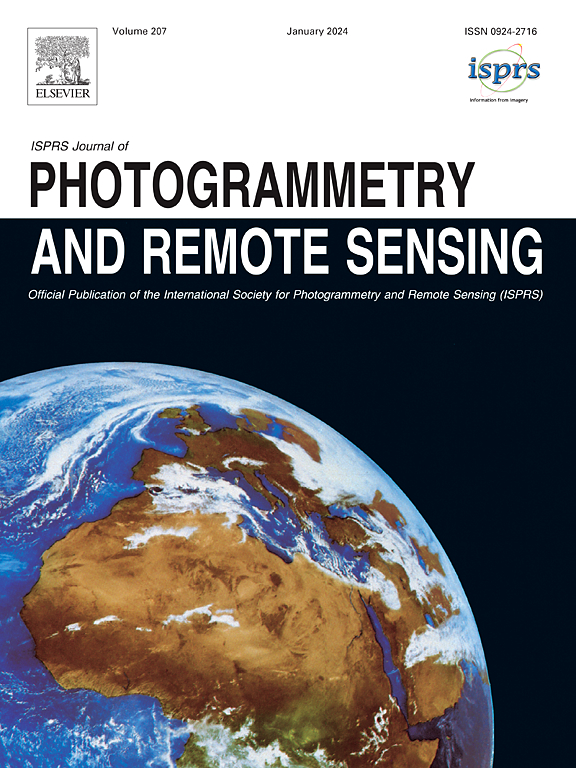A multi-view graph neural network for building age prediction
IF 10.6
1区 地球科学
Q1 GEOGRAPHY, PHYSICAL
ISPRS Journal of Photogrammetry and Remote Sensing
Pub Date : 2024-11-07
DOI:10.1016/j.isprsjprs.2024.10.011
引用次数: 0
Abstract
Building age is crucial for inferring building energy consumption and understanding the interactions between human behavior and urban infrastructure. Limited by the challenges of surveys, some machine learning methods have been utilized to predict and fill in missing building age data using building footprint. However, the existing methods lack explicit modeling of spatial effects and semantic relationships between buildings. To alleviate these challenges, we propose a novel multi-view graph neural network called Building Age Prediction Network (BAPN). The features of spatial autocorrelation, spatial heterogeneity and semantic similarity were extracted and integrated using multiple graph convolutional networks. Inspired by the spatial regime model, a heterogeneity-aware graph convolutional network (HGCN) based on spatial grouping is designed to capture the spatial heterogeneity. Systematic experiments on three large-scale building footprint datasets demonstrate that BAPN outperforms existing machine learning and graph learning models, achieving high accuracy ranging from 61% to 80%. Moreover, missing building age data within the Fifth Ring Road of Beijing was filled, validating the feasibility of BAPN. This research offers new insights for filling the intra-city building age gaps and understanding multiple spatial effects essential for sustainable urban planning.
用于楼龄预测的多视图图神经网络
楼龄对于推断建筑能耗和了解人类行为与城市基础设施之间的相互作用至关重要。受限于调查的挑战,一些机器学习方法已被用来预测和利用建筑物足迹填补缺失的楼龄数据。然而,现有方法缺乏对建筑物之间空间效应和语义关系的明确建模。为了缓解这些挑战,我们提出了一种名为建筑年代预测网络(BAPN)的新型多视图图神经网络。我们使用多个图卷积网络提取并整合了空间自相关性、空间异质性和语义相似性特征。受空间制度模型的启发,设计了基于空间分组的异质性感知图卷积网络(HGCN)来捕捉空间异质性。在三个大规模建筑足迹数据集上进行的系统实验表明,BAPN 的表现优于现有的机器学习和图学习模型,达到了 61% 到 80% 的高准确率。此外,北京五环内缺失的楼龄数据也得到了填补,验证了 BAPN 的可行性。这项研究为填补城市内部楼龄缺口和理解可持续城市规划所必需的多重空间效应提供了新的见解。
本文章由计算机程序翻译,如有差异,请以英文原文为准。
求助全文
约1分钟内获得全文
求助全文
来源期刊

ISPRS Journal of Photogrammetry and Remote Sensing
工程技术-成像科学与照相技术
CiteScore
21.00
自引率
6.30%
发文量
273
审稿时长
40 days
期刊介绍:
The ISPRS Journal of Photogrammetry and Remote Sensing (P&RS) serves as the official journal of the International Society for Photogrammetry and Remote Sensing (ISPRS). It acts as a platform for scientists and professionals worldwide who are involved in various disciplines that utilize photogrammetry, remote sensing, spatial information systems, computer vision, and related fields. The journal aims to facilitate communication and dissemination of advancements in these disciplines, while also acting as a comprehensive source of reference and archive.
P&RS endeavors to publish high-quality, peer-reviewed research papers that are preferably original and have not been published before. These papers can cover scientific/research, technological development, or application/practical aspects. Additionally, the journal welcomes papers that are based on presentations from ISPRS meetings, as long as they are considered significant contributions to the aforementioned fields.
In particular, P&RS encourages the submission of papers that are of broad scientific interest, showcase innovative applications (especially in emerging fields), have an interdisciplinary focus, discuss topics that have received limited attention in P&RS or related journals, or explore new directions in scientific or professional realms. It is preferred that theoretical papers include practical applications, while papers focusing on systems and applications should include a theoretical background.
 求助内容:
求助内容: 应助结果提醒方式:
应助结果提醒方式:


